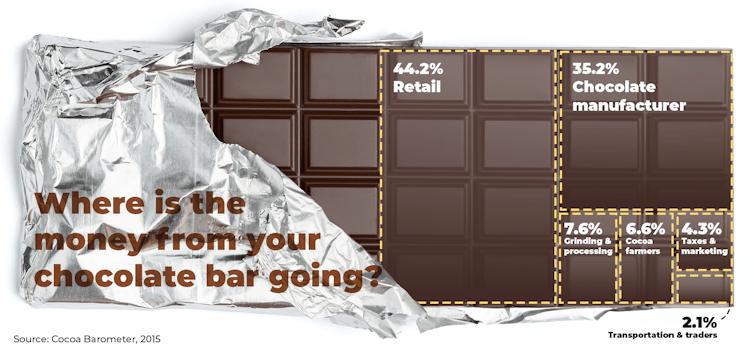
Source: Adobe Stock
Australians enjoy chocolate, consuming on average the equivalent of 32 kilograms a year, but there is growing interest in its origins and how it’s made.
They want to know if their product is sustainably made by companies that only deal with ingredient suppliers who engage in fair labour practices and safeguard against deforestation and other environmentally damaging processes.
But according to the 5th Edition of the Chocolate Scorecard, produced by Be Slavery Free, two Australian universities and several sustainability interest groups, some retailers are lagging when it comes to stocking sustainable products.
The scorecard is released at Easter, the busiest time of the year for the sweet treat. Sales in this period account for 75% of chocolate sold annually in Australia, with the average consumer spending $62 on Easter chocolates.
The scorecard ranks the policies and practices of chocolate traders, manufacturers, brands and retailers, assessing 63 companies on six criteria. These are traceability and transparency, living income, child and forced labor, climate change and deforestation, agroforestry and agrochemical use.
Next year’s report card will also include a rating based on gender equality which is being added as a seventh criteria.
It assesses companies deemed industry leaders in sustainable policies and practices and awards them a green rating (or “egg”), while yellow and orange ratings are given to companies considered to be “progressing” and “needing improvement”. Red is given to those “trailing in policy and practice” and grey indicates a lack of transparency.
This year, the German brand, Ritter Sport, available in some large Australian supermarkets, was given a Good Egg Award in the medium and large company category for its progress and to show bigger companies can do much better.
Dutch brand, Tony’s Chocolonely, was given a special achievement award in the same category for consistently rating green. New Zealand manufacturer Whittaker’s was a highly rated yellow.
Mars Wrigley (maker of Mars bars, Snickers, Milky Way and Twix) rated strongly among the world giants of chocolate, followed by Nestle (Kit Kat, Smarties), Hershey’s (Kisses, chocolate syrup) and Ferrero (Nutella, Kinder, Ferrero Rocher), all of which received yellow awards.
Lindt and Mondelēz, whose portfolio includes Cadbury, Toblerone and Green & Black’s, received orange, indicating the need for improvement.

Globally, no retailers were rated green. Of the stores operating in Australia, Aldi (run by Aldi Sud), received yellow while Woolworths (including Big W) scored a disappointing orange. This was followed by red recipients Coles, David Jones and Kmart.
Chocolate is a growing business
Global revenue from chocolate is expected to reach US$254 billion in 2024. Around US$3.5 billion is generated in Australia and this is expected to grow by nearly 8% over the next few years.
According to the United Nations Guiding Principles on Business and Human Rights, a business is responsible for any and all adverse human rights impacts either through its or its suppliers’ activities. Responsibility should not be shifted to another level in the supply chain.
Research on retail stores reveals confectionery is often an impulse purchase. Stores stock sweet products at payment areas, setting a high profit margin. These products can financially make or break a retailer.
So when a retailer sells chocolate, they have a responsibility to address human rights and environmental issues.

Source: CC BY-SA
Some retailers are falling behind in sustainable sourcing
Unlike other regions, all Australian retailers took part in this year’s chocolate scorecard. These companies were early adopters in responding to human rights and environmental issues through certifications such as Fairtrade and Rainforest Alliance.
But most retailers have poor data on their supply chains. While they develop a code of practice for their manufacturers and suppliers for the chocolate to be certified, it’s up to suppliers to adopt. This cascading model can lead to all responsibility resting with the farmer.
US retailers are the largest in the world and have the resources to lead the way. However, all US retailers received “grey” ratings in this year’s scorecard for not responding. This list includes three of the largest outlets in the US by revenue, Walmart, Costco, and Kroger.
One likely reason the US chocolate industry is lagging is because it has not passed regulations to curb deforestation. The European Union has passed the EU Deforestation Regulation, to ensure commodities such as cocoa, sold in the EU, are not sourced from deforested areas. The UK Environment Act 2021 calls for similar due diligence on critical forest-risk commodities. The US has proposed the Forest Act, but has not passed it.
Making responsible decisions
Retailers need to be aware that consumers are increasingly seeking ethically produced and sustainable products, including chocolate.
Ethically-produced cocoa must become a core element of their corporate responsibility and business strategy. Retailers can make improvements by working with their suppliers and manufacturers to trace their cocoa supply chains to ensure they are untainted by human rights and environmental abuse.
Consumers can use the 5th Edition Chocolate Scorecard to inform their sustainable purchasing decisions about the brands they buy and the retailers they buy from.![]()
Stephanie Perkiss is an associate professor in accounting at the University of Wollongong; Cristiana Bernardi is a senior lecturer in accounting and financial management at The Open University, and John Dumay is a professor in the department of accounting and corporate governance at Macquarie University.
This article is republished from The Conversation under a Creative Commons license. Read the original article.
Handpicked for you

Easter’s coming. How does your favourite chocolate brand fare on child labour and the environment?



COMMENTS
SmartCompany is committed to hosting lively discussions. Help us keep the conversation useful, interesting and welcoming. We aim to publish comments quickly in the interest of promoting robust conversation, but we’re a small team and we deploy filters to protect against legal risk. Occasionally your comment may be held up while it is being reviewed, but we’re working as fast as we can to keep the conversation rolling.
The SmartCompany comment section is members-only content. Please subscribe to leave a comment.
The SmartCompany comment section is members-only content. Please login to leave a comment.